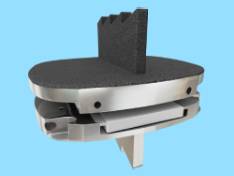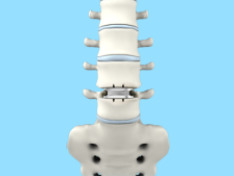Lumbar Artificial Disc Replacement
Lumbar artificial disc replacement is a surgical procedure employed to remove and replace a damaged or worn out disc in the lumbar or lower part of your spine that has become painful and debilitating with an artificial or synthetic disc. An artificial disc is made of metal or plastic or a combination of both and is designed to support the vertebrae while still allowing forward and backward bending, side-to-side bending, and turning. The main objective of the procedure is to relieve back pain and maintain normal motion of the lumbar spine.
What is Lumbar Artificial Disc Replacement?

Lumbar artificial disc replacement is a surgical procedure employed to remove and replace a damaged or worn out disc in the lumbar or lower part of your spine that has become painful and debilitating with an artificial or synthetic disc. An artificial disc is made of metal or plastic or a combination of both and is designed to support the vertebrae while still allowing forward and backward bending, side-to-side bending, and turning. The main objective of the procedure is to relieve back pain and maintain normal motion of the lumbar spine.
Lower (lumbar) back pain can occur as a result of damaged discs either from trauma or degeneration. This can cause the discs to move out of their normal position causing pressure on the spinal cord or nerve roots that exit from the spinal canal at each vertebral level. Gradually, the disrupted disc results in the formation of bone spurs called osteophytes, which can also cause additional pressure on the spinal cord or nerve roots. Disc degeneration and disruption can be a source of lower back pain as well as neurologic symptoms, such as pain, numbness, or weakness that radiates from the back to other regions.
Prodisc L - Lumbar Disc Replacement
Anatomy of the Spine
The spine consists of 33 vertebral bones stacked one on top of the other with cushioning discs lying between each vertebrae. It is divided into 7 cervical vertebrae, 12 thoracic vertebrae, 5 lumbar vertebrae, 5 sacral bones, and 4 coccyx bones. The lumbar spine is composed of the lower 5 vertebrae (lower back), numbered L1–L5. The vertebrae are protected by spongy vertebral discs present between them and is supported by ligaments that hold them together and surround the underlying spinal cord. The spine plays a key role in the smooth movement, stability, and protection of the delicate spinal cord, and giving symmetry and support to the body.
Indications for Lumbar Artificial Disc Replacement
Some of the indications for lumbar artificial disc replacement include several conditions affecting the lumbar spine, such as:
- Arthritis
- Degenerative disc disease (DDD)
- Bone spurs
- Disc herniation
Why Do I need This Procedure?

You may need this procedure if conservative treatment measures have failed to relieve your chronic low back pain and limited range of motion. However, not all candidates are suitable for a lumbar artificial disc replacement surgery. In order to find out if you qualify for this procedure, your physician will conduct a thorough physical exam and order other diagnostic testing, such as a spinal X-ray, magnetic resonance imaging (MRI), computed tomography (CT) scan, myelogram, and/or a bone scan.
In general, lumbar artificial disc replacement may be recommended if:
- Your chronic lower back pain is confined to 1 disc.
- You have not previously had any spinal surgery.
- You have no significant bony compression or facet joint disease, or compression on the nerves of your spine.
- You are not excessively overweight.
- You are at least 18 years old with a good skeletal maturity.
- You are not pregnant or nursing at the time of surgery.
- You are fit and healthy and willing to comply with strict postop instructions.
Preparation for Lumbar Artificial Disc Replacement
Preoperative preparation for lumbar artificial disc replacement includes:
- A thorough examination by your doctor to check for any medical issues that need to be addressed prior to surgery.
- Medical evaluation, blood work, and imaging may be ordered for safely conducting surgery.
- Make sure to tell your doctor if you have any allergies to medications or anesthesia.
- You should inform your doctor of any medications, vitamins, or supplements that you may be taking.
- You should refrain from medications or supplements such as blood thinners, NSAIDs, or vitamin E for several days prior to the surgery.
- You should not consume any solids or liquids after midnight the night before the surgery.
- You need to refrain from smoking/ use of tobacco products and as tobacco affects blood circulation and increases the risk of complications.
- A written consent will be obtained from you after the surgical process has been explained in detail.
How is Lumbar Artificial Disc Replacement Performed?

The surgical procedure is performed under general anesthesia and typically lasts 2 hours and involves the following steps:
- You will be placed in a face-up position and the symptomatic lumbar region is marked for incision.
- Your surgeon will make a small incision.
- Your surgeon will carefully expose the area where the damage disc has been identified.
- X-ray imaging helps the surgeon verify the correct level of surgery.
- Using an operating microscope, your surgeon removes the herniated or damaged disc. Any loose disc fragments are also removed.
- An artificial disc of the appropriate size is then inserted into the disc space.
- Another X-ray is taken to confirm the correct positions of the plates.
- Then the surgeon closes the incision with sutures and covers it with a sterile dressing.
Postoperative Care Instructions and Recovery

Usually, you may have to stay in the hospital for at least 1 day following artificial disc replacement. However, the length of your hospital stay depends on how well you can control your pain and your return to function.
In general, postoperative care instructions involve:
- You will be transferred to the recovery area to be monitored until you are awake from the anesthesia.
- Your nurse will monitor your blood oxygen level and other vital signs as you recover.
- You are encouraged to get up and walk as frequently as possible to prevent blood clot formation.
- You can expect pain and soreness in the surgical area. Pain medications will be prescribed for comfort.
- You may feel some discomfort and nauseous feeling due to the anesthesia used. Anti-nausea medications will be provided to alleviate this discomfort.
- Instructions on surgical site care, driving, and bathing will be provided.
- Instructions on diet rich in Vitamin D and C will be provided to promote bone healing.
- Refrain from smoking as it can negatively affect the healing process.
- Refrain from any strenuous activities and do not lift any heavyweights. You should gradually increase your activity level with light activities; however, you will be able to resume your normal activities as instructed by physician.
- Exercise regimen will be initiated gradually to strengthen your muscles and improve your range of motion.
- Strictly adhere to scheduled follow-up appointments to monitor your progress.





